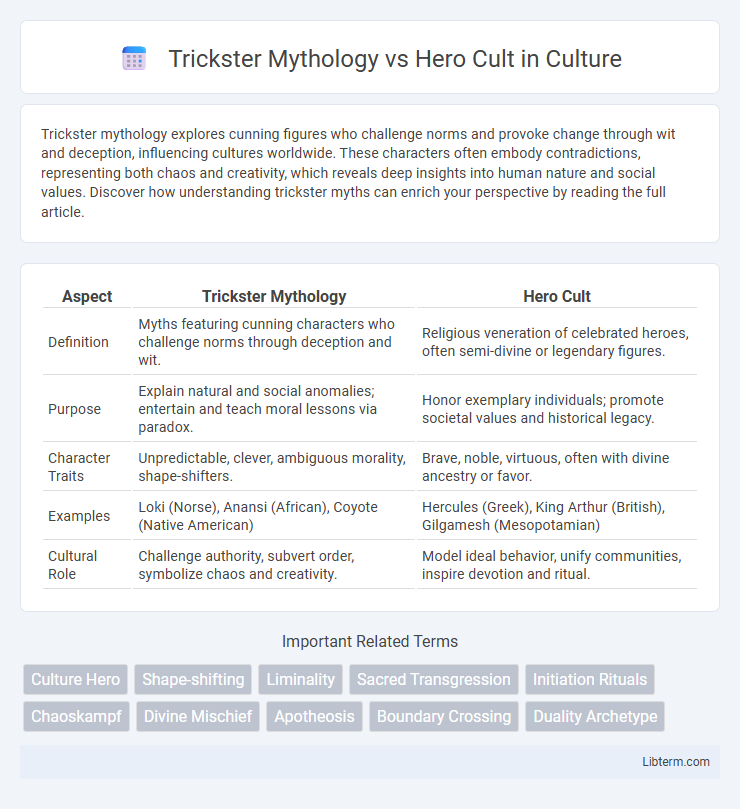Trickster mythology explores cunning figures who challenge norms and provoke change through wit and deception, influencing cultures worldwide. These characters often embody contradictions, representing both chaos and creativity, which reveals deep insights into human nature and social values. Discover how understanding trickster myths can enrich your perspective by reading the full article.
Table of Comparison
| Aspect | Trickster Mythology | Hero Cult |
|---|---|---|
| Definition | Myths featuring cunning characters who challenge norms through deception and wit. | Religious veneration of celebrated heroes, often semi-divine or legendary figures. |
| Purpose | Explain natural and social anomalies; entertain and teach moral lessons via paradox. | Honor exemplary individuals; promote societal values and historical legacy. |
| Character Traits | Unpredictable, clever, ambiguous morality, shape-shifters. | Brave, noble, virtuous, often with divine ancestry or favor. |
| Examples | Loki (Norse), Anansi (African), Coyote (Native American) | Hercules (Greek), King Arthur (British), Gilgamesh (Mesopotamian) |
| Cultural Role | Challenge authority, subvert order, symbolize chaos and creativity. | Model ideal behavior, unify communities, inspire devotion and ritual. |
Origins of Trickster Myths and Hero Cults
Trickster mythology originated in ancient oral traditions, often embodying chaos and subversion in indigenous cultures worldwide, serving as a vehicle for teaching social norms and highlighting human follies. Hero cults emerged in ancient Greece during the Archaic period, rooted in the veneration of semi-divine figures whose exploits bridged mortal and divine realms, fostering communal identity and localized worship. Both systems reflect early societies' attempts to explain human experience through mythic narratives, with tricksters challenging order and heroes reinforcing cultural ideals.
Core Archetypal Differences
The core archetypal difference between Trickster Mythology and Hero Cult lies in their fundamental narrative roles and symbolic functions. Trickster figures embody chaos, subversion, and transformational boundary-crossing, often disrupting order through cunning and deception, while Hero Cult archetypes represent order, virtue, and societal ideals, undertaking quests that reinforce cultural values and norms. This dichotomy reflects broader themes in mythology where Tricksters challenge the status quo and heroes uphold communal integrity.
Symbolism in Trickster vs Hero Narratives
Trickster mythology embodies chaos and transformation, symbolizing unpredictability and the subversion of norms through cunning and humor. Hero cult narratives emphasize order, courage, and moral triumph, with heroes often representing societal ideals and divine favor. The symbolism in trickster versus hero stories reflects a fundamental cultural tension between disruption and stability.
Cultural Roles and Functions
Trickster mythology serves to challenge social norms and provoke critical thinking through subversion, humor, and chaos, often embodying ambiguity and contradiction essential for cultural adaptability. Hero cults emphasize valor, moral exemplarity, and social cohesion by venerating heroes as paragons of communal ideals and sources of collective identity. These roles function complementarily, with tricksters destabilizing rigid structures while heroes reinforce societal values, together shaping cultural narratives and ethical frameworks.
Notable Trickster Figures Across Cultures
Notable trickster figures across cultures include Loki from Norse mythology, Anansi from West African folklore, and Coyote from Native American traditions, each embodying cunning and subversion that challenge societal norms. Unlike hero cults that venerate heroic deeds and moral exemplars, trickster myths emphasize ambiguity and the disruption of order, revealing cultural values through satire and paradox. These figures serve as catalysts for change and reflect complex relationships between chaos and creativity in mythological narratives.
Renowned Heroic Archetypes Worldwide
Renowned heroic archetypes in trickster mythology, such as Loki in Norse lore and Anansi in West African tales, embody cunning intelligence and subversive tactics that challenge societal norms. Hero cults focus on figures like Heracles in Greek mythology and King Arthur in British legends, highlighting valor, strength, and moral virtue as central to their worship and cultural significance. These archetypes reflect diverse symbolic roles across cultures, shaping collective identities through mythic narratives and ritual practices.
Moral Lessons and Social Commentary
Trickster mythology often embodies moral lessons through paradoxical behavior and subversion of norms, highlighting human flaws and societal contradictions by exposing hypocrisy and challenging authority. Hero cults emphasize valor, sacrifice, and adherence to communal values, reinforcing societal ideals and inspiring communal unity through tales of noble deeds and moral exemplars. Both narratives serve critical social commentary by reflecting cultural values: trickster myths provoke reflection on ethical ambiguity, while hero cults promote conformity to established virtues.
Psychological Significance of Tricksters and Heroes
Trickster mythology embodies psychological archetypes that challenge norms, embodying creativity, chaos, and transformation, which facilitates cognitive flexibility and problem-solving skills. Hero cults symbolize the aspirational ideals of bravery, sacrifice, and moral integrity, reinforcing collective identity and personal resilience through mythic narratives. Together, tricksters and heroes serve as complementary forces in the human psyche, balancing order and disorder to promote psychological growth and cultural coherence.
Comparative Influence in Modern Media
Trickster mythology and hero cults both significantly shape modern media through distinct narrative frameworks; tricksters often embody chaos and subversion, inspiring complex antiheroes in films and literature, while hero cults emphasize valor and moral clarity, reinforcing traditional archetypes in superhero genres. The trickster's influence appears in characters who challenge societal norms and provoke critical thinking, evident in works like "Deadpool" or Loki's portrayals. Hero cults drive the popularity of iconic figures such as Superman and Wonder Woman, whose stories reinforce cultural ideals and collective identity.
Enduring Legacy in Contemporary Society
Trickster mythology and hero cults both play pivotal roles in shaping cultural narratives and moral frameworks in contemporary society. Trickster figures, often embodying chaos and subversion, persist in modern media as symbols of rebellion and adaptability, while hero cults continue to inspire collective identity and valorize ideals of courage and sacrifice. The enduring legacy of these archetypes is evident in literature, film, and social movements that reflect ongoing struggles between order and disruption, individualism and communal values.
Trickster Mythology Infographic

 libterm.com
libterm.com